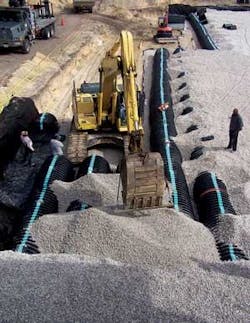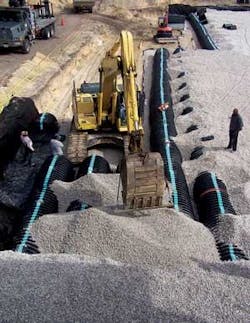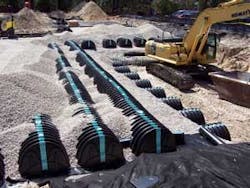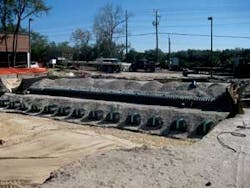Underground Stormwater Systems Solve Space Constraints
By Michael E. Nowak
The James A. Haley Veterans’ Hospital in Tampa, FL, has worked to improve the health of veterans for more than 30 years. Recognized as one of the largest Veterans’ (VA) hospitals and the busiest of four polytrauma facilities in the nation, the hospital provides services to more than 116,000 veterans living in west-central Florida.
To help ease patient traffic, additional clinics are being developed in the vicinity of the Hospital to extend its outpatient services. Among them are the Bruce B. Downs VA clinic and a medical center.
When it came to designing stormwater systems for the two satellite clinics, owner and developer Knut Horneland found that space constraints were among the top challenges he faced. Not only is there little space remaining for new development in a city as densely populated as Tampa, but also drainage ponds, commonly used for stormwater management in Tampa, take up additional valuable space. According to Horneland, the shortage of stormwater drains necessary for detention accounts for the wide use of retention systems in Florida. In retention systems, stormwater is stored without subsequent surface discharge and is infiltrated back into the ground. In detention systems, however, runoff is only temporarily stored until it is cast out to an off-site area, such as a storm drain, pond or wetland.
To save land for development, Horneland opted for underground stormwater systems, which he had successfully used on projects in the past. “As we have so little space available for development in Tampa, we need to use the land both creatively and efficiently,” he said. “The CULTEC underground systems freed up areas that otherwise would have been occupied by stormwater ponds.”
The chambers also proved to be very cost-efficient. Compared to the installation costs of precast and corrugated pipe systems, Horneland saved about 15% on installation costs with the underground system at the medical center site, and about 20% at the Bruce B. Downs clinic site.
Horneland selected CULTEC Recharger® models for both developments. Recharger chambers come in a range of sizes to accommodate various site requirements. They are IAPMO R&T-certified, included in the nationally accepted hydraulic models, and meet HS-25 wheel load requirements.
Each VA clinic installation began with excavating a bed, laying non-woven polypropylene filter fabric along the sides and the bottoms of each bed. Then, a layer of crushed stone was added. The chambers were arranged in the beds and fed using the side portal internal manifold feature. After the chambers were in place, backfilled with six inches of crushed stone and covered with a layer of filter fabric, both sites were then prepared for asphalt.
Project Specifics
Located on the Bruce B. Downs Boulevard, its VA clinic namesake occupies three acres and includes a 16,244-square-foot pharmacy and dermatology clinic and an 18,000-square-foot oncology building with a vault for radiological treatment. Prior to redevelopment, a drainage pond had been used to control the stormwater runoff on-site. Employing the underground system, however, allowed Horneland to gain additional space and place the oncology clinic in the area previously occupied by the stormwater pond.
The new half-acre lot designated for the underground stormwater system posed an interesting challenge for the developer. To reduce the potential of ground subsidence beneath the vault, geotechnical engineers recommended that a downhole vibrator be used to proof the site prior to construction. As a result, the vibratory compaction process compressed the earth, lowering the surface by about a foot.
The CULTEC sales and technical staff helped Horneland select a chamber that would provide the maximum storage capacity given the site’s parameters and space constraints. It was determined that the Recharger 280 HD would be best for this facility, as its heavy-duty construction makes it especially well-suited for high-traffic applications.
To meet the project’s 60,500 cu. ft. storage requirement, the staff designed a two-tier retention system, using 853 Recharger 280 HD units and 2,900 tons of backfill stone. The two-tier configuration minimized the required footprint and featured tiers running in opposite directions to ensure the system’s structural integrity.
The second site – the medical center – is located on 46th Street on a two-acre plot and includes an 11,560-square-foot Audiology Center and a 13,840-square-foot future building pad. To address the clinic’s storage requirements of 30,000 cu. ft., CULTEC designed a retention system using the Recharger V8 chamber, currently the company’s largest-capacity stormwater chamber, providing in excess of 50,000 cu. ft. of storage. More than 450 Recharger V8 units and 3,200 tons of backfill stone were required for a half-acre, single-tier bed.
Design Considerations
In order to calculate each of the two systems’ configurations, the units’ parameters, along with the sites’ workable depths, desired bed areas, and required storage volumes were considered, as well as the fact that the systems would be used for retention. CULTEC also incorporated the storage of the backfill stone porosity at 40%, six-inch stone foundation depths, and typical six-inch chamber spacings. As a result, the company was able to provide the developer with proposed bed layouts, excavation volumes, minimum bed depths and the amount of stone that would be required for each of the installations.
At the VA clinics, the systems collect stormwater runoff in catch basins from each system’s basin inlet structure. The runoff then enters each of the Recharger V8 and 280 HD internal manifold systems and is conveyed throughout the bed of stormwater chambers. The internal manifold, unique to the these chambers, is composed of two side portals located on each chamber and the insertion of High-Volume Low-Velocity (HVLV) Feed Connectors. This feature provides design flexibility, decreases the required installation footprint, and eliminates the need for costly on-site fabricated pipe manifolds.
The underground systems capture, retain and treat large amounts of stormwater runoff in a relatively small footprint, proving to be an ideal solution to land constraint challenges and Federal and state requirements. Employing this system also freed up land that was ultimately used for other valuable purposes at each site.
About the Author:
Michael Nowak is a Field Sales Representative Specialist for CULTEC, Inc.



